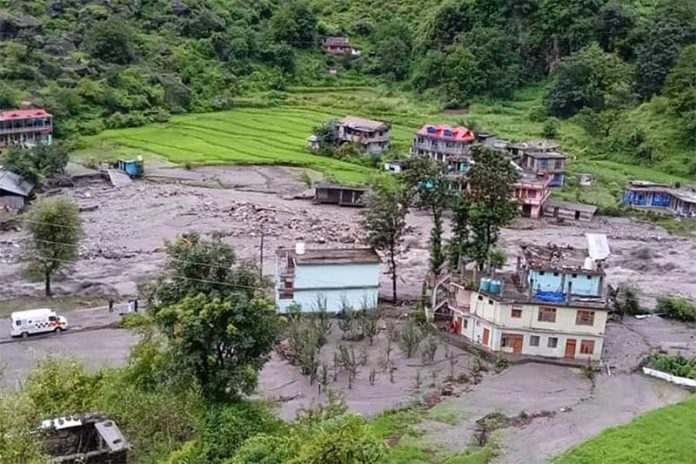NEW DELHI, Aug 4: Heavy rains lashed western and central parts of India on Sunday while a cloudburst in Jammu and Kashmir led to the closure of the arterial Srinagar-Leh national highway, cutting off the Kashmir Valley from Ladakh and rendering the Baltal base camp for the Amarnath Yatra inaccessible.
The death toll in last week’s landslides in Kerala’s Wayanad and Himachal Pradesh rose to 221 and 13, respectively, while more than 370 people, including pilgrims, stranded on the rain-ravaged trek route to Uttarakhand’s Kedarnath, were evacuated.
So far, more than 10,000 people have been rescued from Kedarnath, Bhimbali and Gaurikund. The trek route to Kedarnath suffered extensive damage as a result of a cloudburst in Junglechatti near Lincholi last Wednesday.
Army personnel were deployed at an inundated residential area in Maharashtra’s Pune amid heavy downpours and water discharge from the Khadakwasla dam, officials said.
In view of the discharge of water from Khadakwasla, Mulshi, Pavana and other dams in the Pune region, Maharashtra Chief Minister Eknath Shinde directed authorities to be alert and shift people from dangerous zones to safer places with the assistance of NDRF, SDRF and the Army, if needed.
Officials of Maharashtra’s irrigation department said 35,000 cusecs of water was discharged from the Khadakwasla dam following heavy rainfall in the catchment areas in the past fortnight. The ghat section in Pune district received heavy rainfall in the last two days.
The Nashik district administration has appealed to people to stay alert amid a rise in the water level of the Godavari river due to heavy rains.
An official said that in the wake of incessant rains, 4,000 cusecs of water was released from the Gangapur dam leading to the swelling of the Godavari, increasing the risk of a flood-like situation downstream.
In Jammu and Kashmir, some buildings suffered damage while the Srinagar-Leh national highway was closed following a cloudburst in Ganderbal district that triggered a flash flood.
The highway’s closure has cut off the Kashmir Valley from Ladakh while the Baltal base camp for Amarnath yatra has also been rendered inaccessible.
Heavy rainfall in Jharkhand has led to the swelling of a couple of rivers in the state, forcing the East Singhbhum district administration to issue an alert for people residing in the low-lying areas.
The water level in Kharkai and Swarnarekha rivers has been rising for the last couple of days due to incessant rains in the state.
According to an official release, the water level in the Swarnarekha river was at 116.58 metres at 9 am on Sunday against the danger mark of 121.50 metres. The water level of the Kharkhai was flowing at 126.83 metres against the red mark of 129 metres, it added.
Around 3,500 cusecs of water was released into the Swarnarekha river from the Chandil Dam in the adjoining Seraikela-Kharswan district of Jharkhand.
People residing in the catchment areas have been asked not to venture out near the rivers, and duly follow the directives issued by the administration.
In neighbouring West Bengal, rainfall occurred at most places in all the districts with a few places in Birbhum witnessing heavy showers.
The Damodar Valley Corporation (DVC) released 1.2 lakh cusecs of water from the Panchet and Maithon dams along the Jharkhand-West Bengal border on Sunday morning after heavy discharge of water from Tenughat upstream. A total of 90,000 cusecs of water was released from Panchet and Maithon on Saturday.
Several south Bengal districts, including Purba and Paschim Bardhaman, Birbhum, Paschim and Purba Medinipur, Bankura, Hooghly and Howrah have been impacted by the release of water by DVC.
The death toll due to flash floods triggered by cloudbursts in three districts of Himachal Pradesh increased to 13 with the recovery of four more bodies from Mandi and Shimla districts.
Over 40 people are still missing after a series of cloudbursts occurred in Kullu’s Nirmand, Sainj and Malana, Mandi’s Padhar and Shimla’s Rampur subdivision on the night of July 31 and wreaked havoc.
The rescue operations are still underway and sniffer dogs, drones and other equipment are also being used to locate the missing people. According to officials, 410 rescuers from the Army, NDRF, SDRF, ITBP, CISF, Himachal Pradesh Police and home guards are involved in the hunt.
A total of 87 roads are still closed in the state. The local meteorological office has warned of heavy showers, thunderstorms and lightning at isolated places in Himachal Pradesh till August 8.
Intermittent rains lashed parts of Himachal Pradesh with Hamirpur receiving the highest rainfall at 54 mm since Friday evening, followed by Berthin and Dharamshala at 19 mm each, Neri 11 mm, Kangra 9.7 mm, Kukumseri 9.6 mm, Sundernagar 8.1 mm, Manali and Chamba 6 mm each and Bajaura 5 mm.
Rescue operations in landslide-hit areas of Kerala’s Wayanad district continued for the sixth day as authorities intensified efforts to recover bodies and also prepared a mass grave for unidentified remains.
Hundreds of personnel from various forces, including the NDRF, Army, Navy, Coast Guard and Special Operations Group, were deployed in the disaster-struck areas.
According to State Revenue Minister K Rajan, 221 bodies and 166 body parts have been recovered so far. The number of missing people has gone down to 180 from the earlier 206 after authorities were able to get in touch with some of them over the phone, he said.
Search operations also continued along the Chaliyar river that flows through Wayanad, Malappuram and Kozhikode. The river has become a haunting symbol of destruction after the bodies of those who died in the Wayanad landslides washed up on its banks.
The total number of bodies found in the Chaliyar river is 74, and body parts is 134, making a grim total of 208, officials said.
The India Meteorological Department has warned of heavy to very heavy rainfall in eastern, northeastern and northern parts of the country on Monday while isolated places in Bihar Jharkhand and Uttar Pradesh are likely to witness thunderstorms accompanied by lightning. (PTI)


